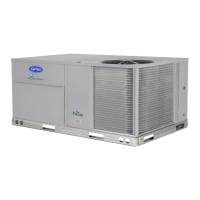10
The curb should be level. This is necessary for unit drain to
function properly. Unit leveling tolerances are show in Fig. 7.
Refer to Accessory Roof Curb Installation Instructions for ad-
ditional information as required.
Fig. 7 — Unit Leveling Tolerances
Install insulation, cant strips, roofing felt, and counter flashing
as shown. Ductwork must be attached to curb and not to the
unit. The accessory thru-the-base power package must be in-
stalled before the unit is set on the roof curb.
If electric and control wiring is to be routed through the basepan,
attach the accessory thru-the-base service connections to the base-
pan in accordance with the accessory installation instructions.
NOTE: The gasketing of the unit to the roof curb is critical for a
watertight seal. Install gasket supplied with the roof curb as shown
in Fig. 6. Improperly applied gasket can also result in air leaks and
poor unit performance.
SLAB MOUNT (HORIZONTAL UNITS ONLY)
Provide a level concrete slab that extends a minimum of 6-in.
(150 mm) beyond unit cabinet. Install a gravel apron in front of
condenser coil air inlet to prevent grass and foliage from ob-
structing airflow.
NOTE: Horizontal units may be installed on a roof curb if
required.
ALTERNATE UNIT SUPPORT (IN LIEU OF CURB OR
SLAB MOUNT)
A non-combustible sleeper rail can be used in the unit curb
support area. If sleeper rails cannot be used, support the long
sides of the unit with a minimum of 3 equally spaced 4-in. x
4-in. (102 mm x 102 mm) pads on each side.
Step 5 — Field Fabricate Ductwork
Cabinet return-air static pressure (a negative condition) shall
not exceed 0.35 in. wg (87 Pa) with economizer or 0.45 in. wg
(112 Pa) without economizer.
For vertical ducted applications, secure all ducts to roof curb
and building structure. Do not connect ductwork to unit.
Fabricate supply ductwork so that the cross sectional dimen-
sions are equal to or greater than the unit supply duct opening
dimensions for the first 18-in. (458 mm) of duct length from
the unit basepan.
Ducts passing through unconditioned spaces must be insulated
and covered with a vapor barrier.
If a plenum return is used on a vertical unit, the return should
be ducted through the roof deck to comply with applicable fire
codes.
FOR UNITS WITH ACCESSORY ELECTRIC HEATERS
All installations require a minimum clearance to combustible
surfaces of 1-in. (25 mm) from duct for first 12-in. (305 mm)
away from unit.
Outlet grilles must not lie directly below unit discharge.
NOTE: A 90-degree elbow must be provided in the ductwork
to comply with UL (Underwriters Laboratories) code for use
with electric heat.
Step 6 — Rig and Place Unit
A-B
0.5″ (13)
B-C
1.0″ (25)
A-C
1.0″ (25)
MAXIMUM ALLOWABLE
DIFFERENCE IN. (MM)
CAUTION
PROPERTY DAMAGE HAZARD
Failure to follow this caution may result in damage to roofing
materials.
Membrane roofs can be cut by sharp sheet metal edges. Be
careful when placing any sheet metal parts on such roof.
WARNING
PERSONAL INJURY HAZARD
Failure to follow this warning could cause personal injury.
For vertical supply and return units, tools or parts could drop
into ductwork and cause an injury. Install a 90 degree turn in
the return ductwork between the unit and the conditioned
space. If a 90 degree elbow cannot be installed, then a grille
of sufficient strength and density should be installed to pre-
vent objects from falling into the conditioned space. Due to
electric heater, supply duct will require 90 degree elbow.
CAUTION
UNIT DAMAGE HAZARD
Failure to follow this caution may result in equipment damage.
All panels must be in place when rigging. Unit is not designed
for handling by fork truck when packaging is removed.
If using top crate as spreader bar, once unit is set, carefully
lower wooden crate off building roof top to ground. Ensure
that no people or obstructions are below prior to lowering the
crate.

